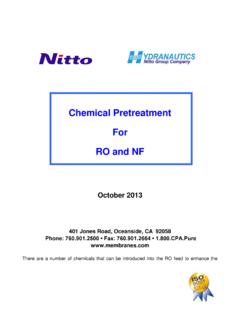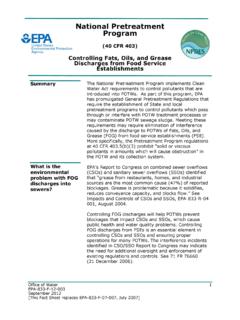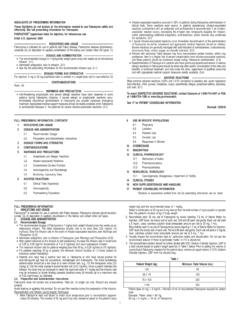Transcription of SURFACE PRETREATMENT BY PHOSPHATE CONVERSION …
1 130. 9 (2005) 130-177 Sankara Narayanan SURFACE PRETREATMENT BY PHOSPHATE . CONVERSION COATINGS A REVIEW. Sankara Narayanan National Metallurgical Laboratory, Madras Centre CSIR, Complex, Taramani, Chennai-600 113, India Received: April 22, 2005. Abstract. Phosphating is the most widely used metal PRETREATMENT process for the SURFACE treatment and finishing of ferrous and non-ferrous metals. Due to its economy, speed of opera- tion and ability to afford excellent corrosion resistance, wear resistance, adhesion and lubricative properties, it plays a significant role in the automobile, process and appliance industries. Though the process was initially developed as a simple method of preventing corrosion, the changing end uses of phosphated articles have forced the modification of the existing processes and development of innovative methods to substitute the conventional ones.
2 To keep pace with the rapid changing need of the finishing systems, numerous modifications have been put forth in their development - both in the processing sequence as well as in the phosphating formulations. This review addresses the various aspects of phosphating in detail. In spite of the numerous modifications put forth on the deposition technologies to achieve different types of coatings and desirable properties such as improved corrosion resistance, wear resistance, etc., PHOSPHATE CONVERSION coating still plays a vital part in the automobile, process and appliance industries. Contents Phosphating 1. Introduction Rinsing after phosphating 2. Chemical CONVERSION coatings Chromic acid sealing 3.
3 Phosphating Drying History and development of the coating characteristics phosphating process Structure and composition Chemistry of phosphating coating thickness and coating weight Acceleration of the phosphating coating porosity process Stability of the PHOSPHATE coating Chemical acceleration Influence of various factors on coating Mechanical acceleration properties Electrochemical acceleration Nature of the substrate Kinetics of the phosphating process Composition of the metal Process details Structure of the metal SURFACE Cleaning SURFACE preparation Rinsing SURFACE activation Corresponding author: Sankara Narayanan, e-mail: 2005 Advanced Study Center Co.
4 Ltd. SURFACE PRETREATMENT by PHOSPHATE CONVERSION coatings a review 131. Thermal treatments and machining (iii) ion implantation; (iv) laser treatment; (v) deposi- Phosphating parameters tion by thermal spray, plasma spray and arc meth- Processing problems and remedial ods; (vi) nitriding; (vii) carbiding; etc., or through more measures conventional techniques such as: (i) painting; (ii). Defects in coatings and remedies anodizing; and (iii) chemical CONVERSION coatings. Characterization of PHOSPHATE While the former methods are usually less economic coatings as they involve the use of sophisticated application Testing the quality of PHOSPHATE techniques and are meant for specialized applica- coatings tions, the latter methods are more cost-effective and Evaluation of physical have a wider spectrum of end applications.
5 Characteristics Evaluation of corrosion performance 2. CHEMICAL CONVERSION . Applications COATINGS. Environmental impact 4. Summary Chemical CONVERSION coatings are adherent, in- References soluble, inorganic crystalline or amorphous SURFACE films, formed as an integral part of the metal sur- face by means of a non-electrolytic chemical reac- 1. INTRODUCTION. tion between the metal SURFACE and the dipped in Metals have been the backbone of civilization. Ef- solution [6]. In such coatings, a portion of the base forts have been spared to find alternatives and re- metal is converted into one of the components of placements for metals but these still play a major the resultant protective film, which is much less re- role in the manufacture and construction and are active to subsequent corrosion than the original metal likely to do so for many more years.
6 This is due to SURFACE . This film imparts an equal potential to the the combination of several useful properties like metal SURFACE , neutralizing the potential of the local strength, workability, low-cost and ability to be re- anodic and cathodic galvanic corrosion sites [7]. cycled, that the metals possess. However, metals They also serve as absorptive bases for improving which are extracted from their ores by chemical or the adhesion to paints and other organic finishes. electrochemical means show a strong tendency to Chemical CONVERSION coatings are preferred because revert to their oxide form at the first available oppor- of their adherent nature and high speed of coating tunity, , they tend to corrode [1-4] and as a re- formation besides being economical.
7 Further these sult they create a tremendous economic loss be- can be formed using simple equipment and without sides posing a serious threat to the national re- the application of any external potential. Chemical sources of a country. CONVERSION coating processes are classified as phos- The methods of corrosion prevention are many phating, chromating and oxalating according to their and varied. These methods may be generally clas- essential constituents viz., phosphates, chromates, sified [3] as: and oxalates respectively [8]. The present review Modification of the metal by alloying and/or sur- focuses on PHOSPHATE CONVERSION coatings with a face modification; special emphasize on zinc PHOSPHATE coatings on Modification of the environment by the use of in- mild steel.
8 Hibitors; and Change of metal/environment potential by ca- 3. PHOSPHATING. thodic or anodic protection. Phosphating process can be defined as the treat- The most commonly used method of corrosion ment of a metal SURFACE so as to give a reasonably protection involves bulk alloying or SURFACE modifi- hard, electrically non-conducting SURFACE coating of cation. SURFACE modification is however, far more insoluble PHOSPHATE which is contiguous and highly economical than bulk alloying and is more widely adherent to the underlying metal and is consider- practiced. The methods generally used for SURFACE ably more absorptive than the metal [9]. The coat- modification involve the formation of a physical bar- ing is formed as a result of a topochemical reac- rier to protect the metal against its corrosive envi- tion, which causes the SURFACE of the base metal to ronment [5].
9 This can be achieved by relatively more integrate itself as a part of the corrosion resistant modern methods such as: (i) physical vapour depo- film. sition (PVD); (ii) chemical vapour deposition (CVD);. 132 Sankara Narayanan Table 1. Historical development of the phosphating process. Sl. Year/ Advancement made/process developed References No. Period 1. 1906 Phosphating of iron and steel using phosphoric acid and iron filings 11. 2. 1908 Treatment of PHOSPHATE coatings with oxidizing agents to reduce 12. process time 3. 1909 Regeneration of the bath and formulation of zinc PHOSPHATE baths 13,14. requiring high temperature process time of one hour 4.
10 1911 Formulation of manganese PHOSPHATE bath requiring high temperature - 15. process time of hours 5. 1914 Parkerising process with maintenance of total acid to free acid ratio 16,17. 6. 1928 Recognition of PHOSPHATE coating as paint base 18,19. 7. 1929 Bonderizing process with the addition of Copper accelerator- coating 20. time: 10 minutes to 1 hour 8. 1933 Use of oxidizing agents like nitrate for acceleration coating time: 21. 5 minutes 9. 1934 Use of PHOSPHATE coating for cold working operations for metals 22. 10. 1937 Spray phosphating phospating time: 60-90 seconds 23. 11. 1940 Development of non- coating PHOSPHATE process based on sodium 24. or ammonium phosphates 12.





